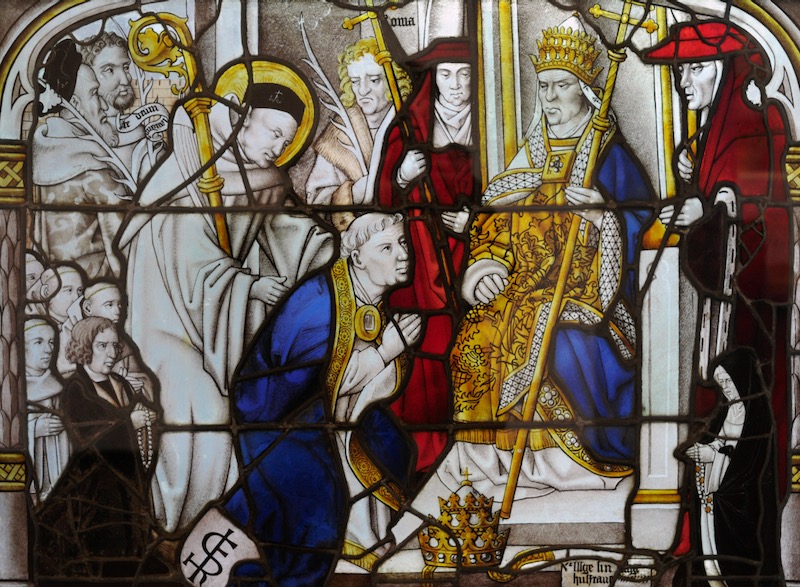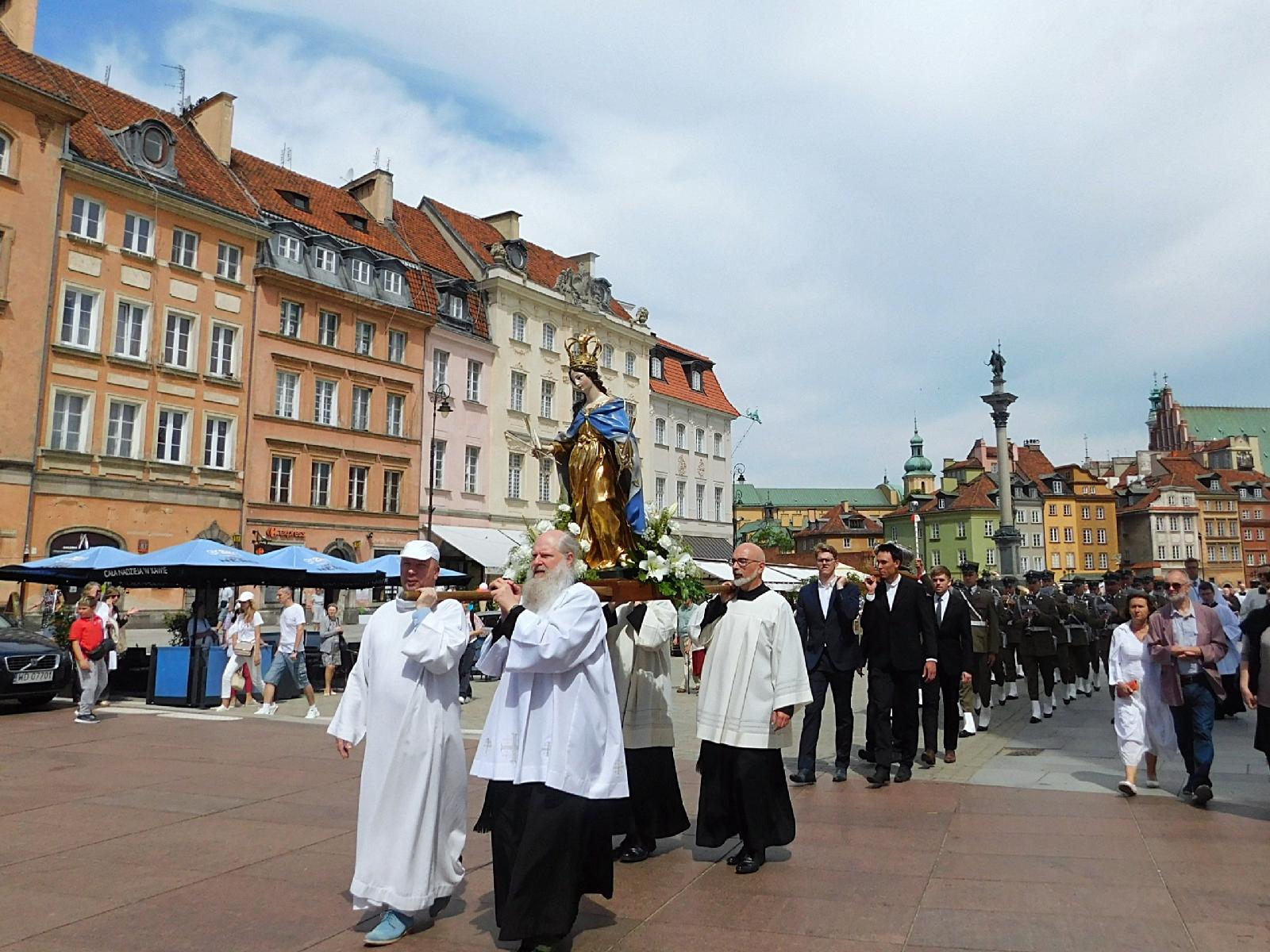Today’s feast owes its existence to a vision reported by a Béguine, Julienne de Cornillon (1193-1258), in 1230. It started life as a feast local to Liège, in what is now Belgium, until Julienne, helped by local Dominicans, persuaded Pope Urban IV (1195-1264), himself a former Archdeacon of Liège, to promulgate it in 1264 as a feast of the universal Church, the first such. The Pope invited no less than St Thomas Aquinas (1225-74) to compose the liturgy for the feast, that is, the prayers of the Mass and the Divine Office, which still includes familiar hymns such as Tantum Ergo and O Salutaris Hostia. It would be another fifty years before the feast of Corpus Christi arrived in England.
By the end of the 14th century, it had become one of the four days in the year, the dies praedicabiles, on which sermons were preached in Great St Mary’s, the University church here in Cambridge. The Eucharist has at its centre the simplest and, quite literally, the most vital of all human activities, namely, eating and drinking which, along with the most ordinary things of everyday life, bread and wine, become the means through which God enters our quotidian human lives in order thereby to draw us into the unfathomable mystery of his divine life and, in the process, uniting us not only to himself but to one another.
Bread and wine are, of course, natural symbols of life, as such, even before they become the sacramental signs of Christ’s divine life. It’s not difficult to see why. Wheat is one of the greatest of all humankind’s civilising innovations, intensively cultivated since at least the sixth millennium BC, and now covering more than 600 million acres of this planet’s surface, much of it, poignantly, in the Ukraine. Though it’s now thought that the original by-product of wheat wasn’t bread, but beer – if so, it was the demand for beer, not bread, that first induced human beings to cultivate wheat and practise agriculture – bread remains profoundly symbolic of physical sustenance and, therefore, life itself.
As for wine, it’s reassuringly significant that throughout the Old Testament, there’s no more potent symbol of stability, contentment, and peace, than the vine. Unsurprisingly, the Psalmist says of its fruit that it “rejoiceth the heart of man” (sic), another sentiment echoed throughout the Old Testament. After Israel’s liberation from Egypt, they wandered in the wilderness without any means of feeding themselves. God’s first intervention on behalf of his people was to provide food to sustain them on their journey.
The manna that the wandering Israelites found on the ground each morning was, quite literally, bread from heaven; and the Passover meal from that time till now celebrates their exodus from Egypt and their arrival in the Promised Land. It was at the Passover meal which Jesus shared with his friends on the eve of his execution by the Roman authorities, that something entirely new happened. Jesus took the bread and wine of the Passover, the staples and symbols of life and nourishment, and identified himself with them. He identified himself, in other words, as our sustenance, like the manna from heaven, for the journey through this life into the Promised Land, which is eternal life. But this was more than physical sustenance.
At the Last Supper, he made it clear that this sustenance, which is his own self, satisfies a hunger far deeper than physical hunger. More than anything else in this life, what we hunger for is love and friendship; and we know intuitively and from experience that to satisfy that hunger, love and friendship must be unconditional and unending. Thus, when Jesus says, “This is my Body, which will be given up for you” - or, more directly, “This bread and this wine are me for you” – his words are unmistakably words of unconditional and unending love and friendship.
What else do we mean (if we really mean it) when we tell someone we love them? Out of love for us, then, Jesus becomes in the Eucharist our bread of life, sharing his own divine life with us, his friends. Now normally, of course, the food we eat becomes part of us. But in the Eucharist, this is reversed: we become part of what we eat. So, St Augustine can say that he, Jesus, gives us his body to make us into his Body, the Church. Bread and wine are changed into Christ Himself: but the equally profound mystery in the Eucharist is that we too are changed, both individually and together. We become members of his Body, sharers of his life, united to him to one another. The ultimate point of the Eucharist, then, which is the ultimate point of life itself, is friendship, with God and with one another. Aquinas points out that it is the most natural thing in the world for friends to want to share their lives, to want to be together.
He sums all this up with his usual succinctness and clarity: What is entirely proper to friendship is to live with one’s friends…and that is why Christ, who promised us his bodily presence…did not want to deprive us of that presence during our pilgrimage, but by his body and blood joins us to himself in this sacrament…Thus this sacrament is the sign of the greatest love and the greatest hope, because it is intimate union with Christ. The Eucharist is the primal act of love by which Christ Himself, God made man, shares his life with us, his friends. It is, in other words, the sacrament of friendship.
But, as St Thomas adds, it is also the sacrament of hope. Hope looks forward to a future, not as yet realised, when we will experience fully what we now know only partially, namely, the transformation of our lives and the whole of creation that will fulfil everything for which we have hoped and longed for in this life. Again, all this is summed up by St Thomas in one of the prayers he composed for the feast, O sacrum Convivium, O Holy Banquet: This is a holy banquet indeed, in which Christ himself is made our food: the memory of his passion is told again, grace fills the mind and heart, and there is given to us an assurance of the glory that, one day, will be ours.



 Loading ...
Loading ...
What do you think?
You can post as a subscriber user ...
User comments (0)